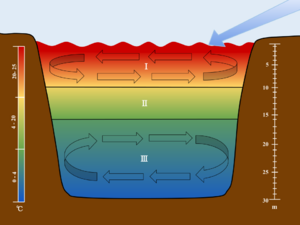Biology:Hypolimnion

I. The Epilimnion
II. The Metalimnion
III. The Hypolimnion
The scales are used to associate each section of the stratification to their corresponding depths and temperatures. The arrow is used to show the movement of wind over the surface of the water which initiates the turnover in the epilimnion and the hypolimnion.
The hypolimnion or under lake is the dense, bottom layer of water in a thermally-stratified lake.[1] The word "hypolimnion" is derived from Ancient Greek:.[2] It is the layer that lies below the thermocline.
Typically the hypolimnion is the coldest layer of a lake in summer, and the warmest layer during winter.[1] In deep, temperate lakes, the bottom-most waters of the hypolimnion are typically close to 4 °C throughout the year. The hypolimnion may be much warmer in lakes at warmer latitudes. Being at depth, it is isolated from surface wind-mixing during summer,[3] and usually receives insufficient irradiance (light) for photosynthesis to occur.
Oxygen dynamics
The deepest portions of the hypolimnion have low oxygen concentrations.[4] In eutrophic lakes, the hypolimnion is often anoxic.[5] Deep mixing of lakes during the fall and early winter[6] allows oxygen to be transported from the epilimnion to the hypolimnion.[7] The cooling of the epilimnion during the fall reduces lake stratification and allows for mixing to occur.[1] The hypolimnion can be anoxic for up to half the year.[6] Anoxia is more common in the hypolimnion during the summer when mixing does not occur.[1] In the absence of oxygen from the epilimnion, decomposition can cause hypoxia in the hypolimnion.[8]
Hypolimnetic aeration
In eutrophic lakes where the hypolimnion is anoxic, hypolimnetic aeration may be used to add oxygen to the hypolimnion.[1] Adding oxygen to the system through aeration can be costly because it requires significant amounts of energy.[1]
See also
- Metalimnion
References
- ↑ 1.0 1.1 1.2 1.3 1.4 1.5 Dodds, Walter K. (Walter Kennedy), 1958- (2010). Freshwater ecology : concepts and environmental applications of limnology. Whiles, Matt R. (2nd ed.). Burlington, MA: Academic Press. ISBN 978-0-12-374724-2. OCLC 784140625.
- ↑ Sadchikov, A. P.; Ostroumov, S. A. (October 2019). "Epilimnion, Metalimnion, and Hypolimnion of a Mesotrophic Aquatic Ecosystem: Functional Role of the Vertical Structure of the Reservoir Ecosystem in Terms of Hydrochemical and Biological Parameters" (in en). Russian Journal of General Chemistry 89 (13): 2860–2864. doi:10.1134/S107036321913019X. ISSN 1070-3632.
- ↑ Weinke, Anthony D.; Biddanda, Bopaiah A. (2019-12-01). "Influence of episodic wind events on thermal stratification and bottom water hypoxia in a Great Lakes estuary" (in en). Journal of Great Lakes Research 45 (6): 1103–1112. doi:10.1016/j.jglr.2019.09.025. ISSN 0380-1330. http://www.sciencedirect.com/science/article/pii/S038013301930187X.
- ↑ Sadchikov, A. P.; Ostroumov, S. A. (October 2019). "Epilimnion, Metalimnion, and Hypolimnion of a Mesotrophic Aquatic Ecosystem: Functional Role of the Vertical Structure of the Reservoir Ecosystem in Terms of Hydrochemical and Biological Parameters" (in en). Russian Journal of General Chemistry 89 (13): 2860–2864. doi:10.1134/S107036321913019X. ISSN 1070-3632.
- ↑ Su, Xiaoxuan; He, Qiang; Mao, Yufeng; Chen, Yi; Hu, Zhi (2019-01-01). "Dissolved oxygen stratification changes nitrogen speciation and transformation in a stratified lake" (in en). Environmental Science and Pollution Research 26 (3): 2898–2907. doi:10.1007/s11356-018-3716-1. ISSN 1614-7499. PMID 30499088.
- ↑ 6.0 6.1 Sánchez-España, Javier; Mata, M. Pilar; Vegas, Juana; Morellón, Mario; Rodríguez, Juan Antonio; Salazar, Ángel; Yusta, Iñaki; Chaos, Aida et al. (2017-12-01). "Anthropogenic and climatic factors enhancing hypolimnetic anoxia in a temperate mountain lake" (in en). Journal of Hydrology 555: 832–850. doi:10.1016/j.jhydrol.2017.10.049. ISSN 0022-1694. Bibcode: 2017JHyd..555..832S. http://www.sciencedirect.com/science/article/pii/S0022169417307254.
- ↑ Sahoo, G. B.; Schladow, S. G.; Reuter, J. E.; Coats, R. (2010-07-09). "Effects of climate change on thermal properties of lakes and reservoirs, and possible implications". Stochastic Environmental Research and Risk Assessment 25 (4): 445–456. doi:10.1007/s00477-010-0414-z. ISSN 1436-3240.
- ↑ Weinke, Anthony D.; Biddanda, Bopaiah A. (2019-12-01). "Influence of episodic wind events on thermal stratification and bottom water hypoxia in a Great Lakes estuary" (in en). Journal of Great Lakes Research 45 (6): 1103–1112. doi:10.1016/j.jglr.2019.09.025. ISSN 0380-1330. http://www.sciencedirect.com/science/article/pii/S038013301930187X.
External links
 |

